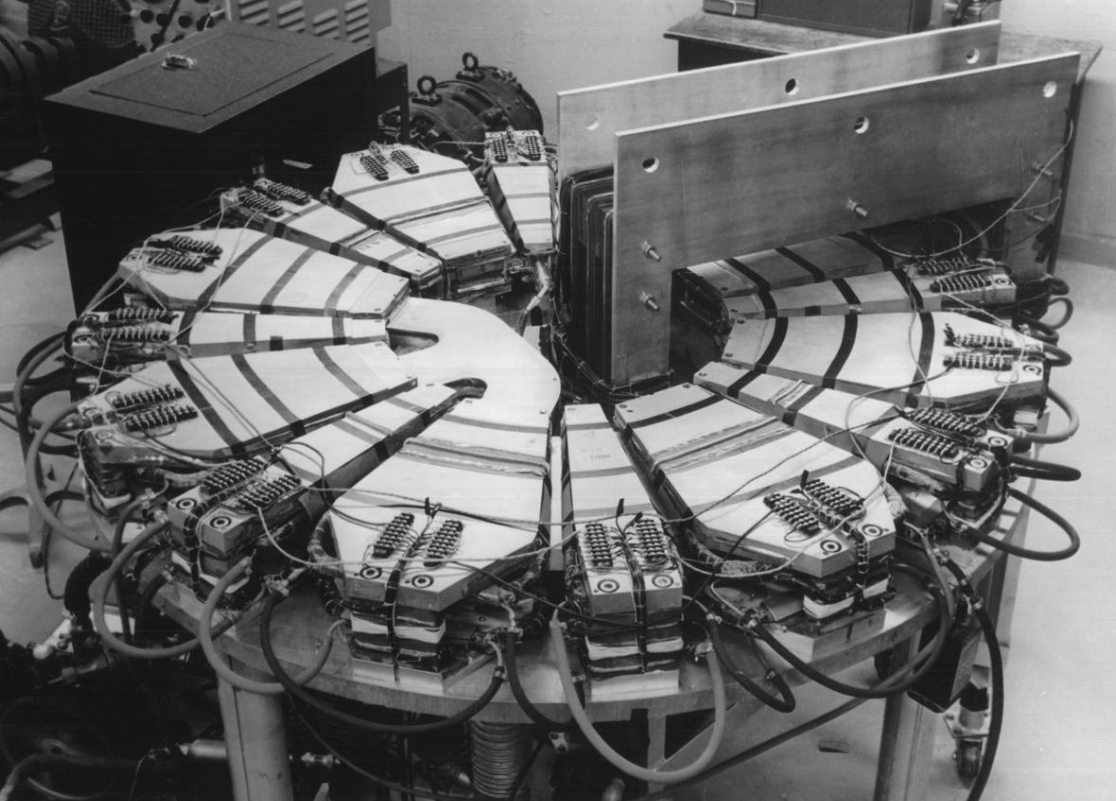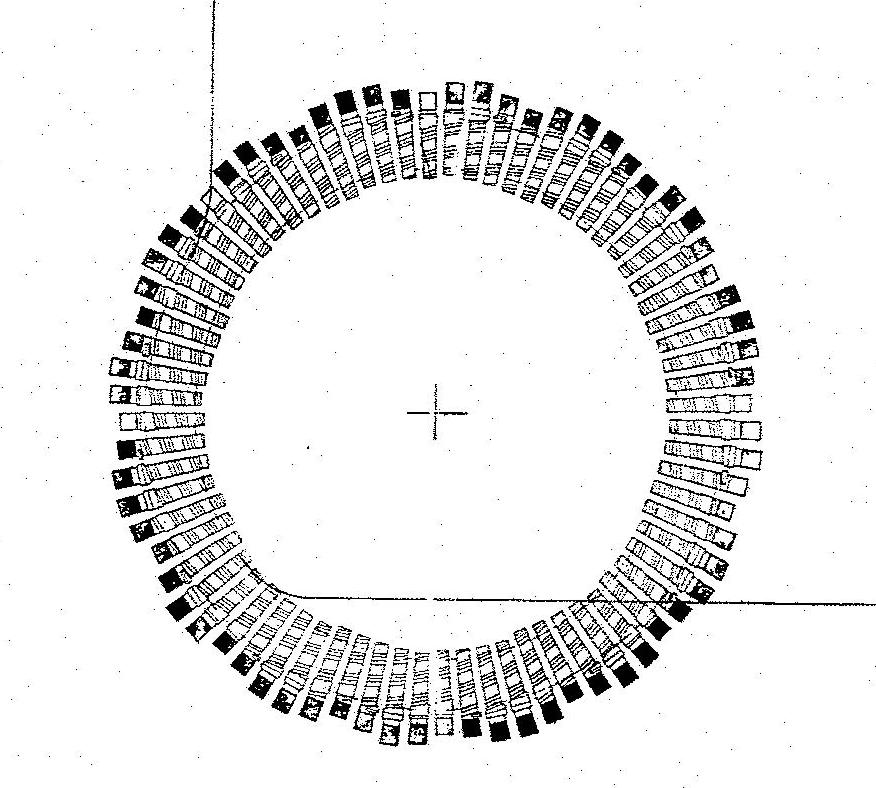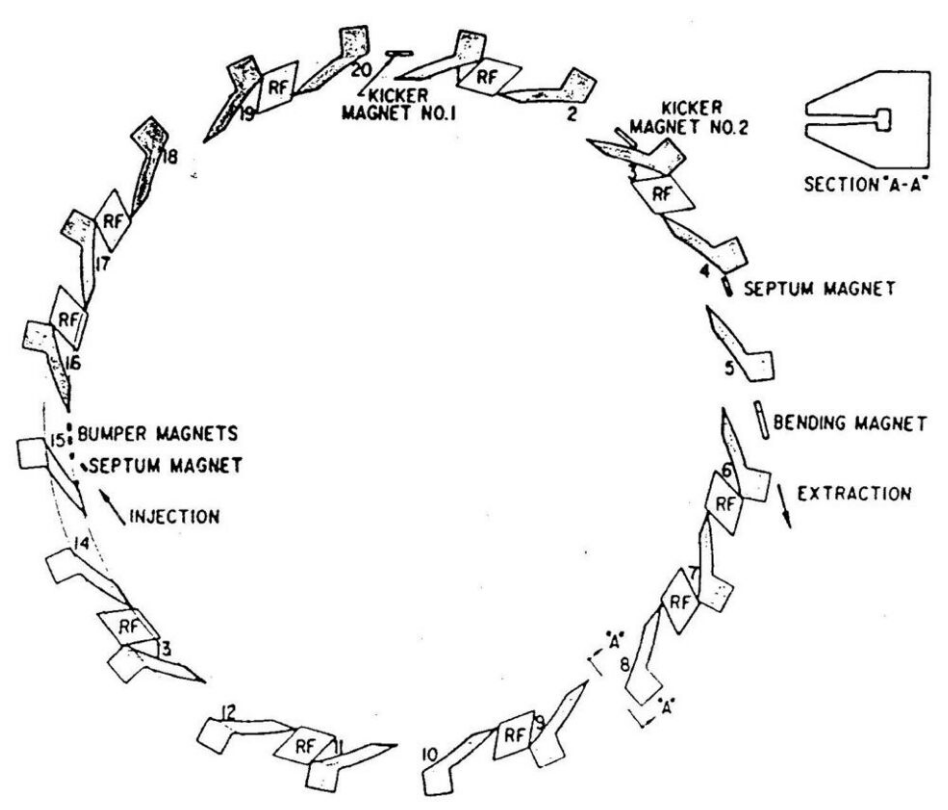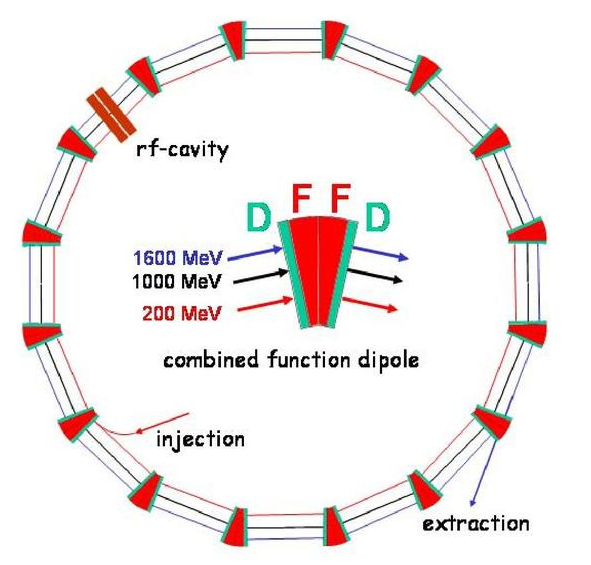
| Version | Summary | Created by | Modification | Content Size | Created at | Operation |
|---|---|---|---|---|---|---|
| 1 | Camila Xu | -- | 1467 | 2022-10-31 01:46:44 |
Video Upload Options
A Fixed-Field Alternating Gradient accelerator (FFAG) is a circular particle accelerator concept on which development was started in the early 50s, and that can be characterized by its time-independent magnetic fields (fixed-field, like in a cyclotron) and the use of strong focusing (alternating gradient, like in a synchrotron). Thus, FFAG accelerators combine the cyclotron's advantage of continuous, unpulsed operation, with the synchrotron's relatively inexpensive small magnet ring, of narrow bore. Although the development of FFAGs had not been pursued for over a decade starting from 1967, it has regained interest since the mid-1980s for usage in neutron spallation sources, as a driver for muon colliders and to accelerate muons in a neutrino factory since the mid-1990s. The revival in FFAG research has been particularly strong in Japan with the construction of several rings. This resurgence has been prompted in part by advances in RF cavities and in magnet design.
1. History
1.1. First Development Phase

The idea of fixed-field alternating-gradient synchrotrons was developed independently in Japan by Tihiro Ohkawa, in the United States by Keith Symon, and in Russia by Andrei Kolomensky. The first prototype, built by Lawrence W. Jones and Kent M. Terwilliger at the University of Michigan used betatron acceleration and was operational in early 1956.[1] That fall, the prototype was moved to the Midwestern Universities Research Association (MURA) lab at University of Wisconsin, where it was converted to a 500 keV electron synchrotron.[2] Symon's patent, filed in early 1956, uses the terms "FFAG accelerator" and "FFAG synchrotron".[3] Ohkawa worked with Symon and the MURA team for several years starting in 1955.[4]
Donald Kerst, working with Symon, filed a patent for the spiral-sector FFAG accelerator at around the same time as Symon's Radial Sector patent.[5] A very small spiral sector machine was built in 1957, and a 50 MeV radial sector machine was operated in 1961. This last machine was based on Ohkawa's patent, filed in 1957, for a symmetrical machine able to simultaneously accelerate identical particles in both clockwise and counterclockwise beams.[6] This was one of the first colliding beam accelerators, although this feature was not used when it was put to practical use as the injector for the Tantalus storage ring at what would become the Synchrotron Radiation Center.[7] The 50MeV machine was finally retired in the early 1970s.[8]

Layout of MURA FFAG
MURA designed 10 GeV and 12.5 GeV proton FFAGs that were not funded.[9] Two scaled down designs, one for 720 MeV[10] and one for a 500 MeV injector,[11] were published.
With the shutdown of MURA which began 1963 and ended 1967,[12] the FFAG concept was not in use on an existing accelerator design and thus was not actively discussed for some time.
1.2. Continuing Development


In the early 1980s, it was suggested by Phil Meads that an FFAG was suitable and advantageous as a proton accelerator for an intense spallation neutron source,[14] starting off projects like the Argonne Tandem Linear Accelerator at Argonne National Laboratory[15] and the Cooler Synchrotron at Jülich Research Centre.[16]
Conferences exploring this possibility were held at Jülich Research Centre, starting from 1984.[17] There have also been numerous annual workshops focusing on FFAG accelerators[18] at CERN, KEK, BNL, TRIUMF, Fermilab, and the Reactor Research Institute at Kyoto University.[19] In 1992, the European Particle Accelerator Conference at CERN was about FFAG accelerators.[20][21]
The first proton FFAG was successfully construction in 2000,[22] initiating a boom of FFAG activities in high-energy physics and medicine.
With superconducting magnets, the required length of the FFAG magnets scales roughly as the inverse square of the magnetic field.[23] In 1994, a coil shape which provided the required field with no iron was derived.[24] This magnet design was continued by S. Martin et al. from Jülich.[20][25]
In 2010, after the workshop on FFAG accelerators in Kyoto, the construction of the Electron Machine with Many Applications (EMMA) was completed at Daresbury Laboratory, UK. This was the first non-scaling FFAG accelerator. Non-scaling FFAGs are often advantageous to scaling FFAGs because large and heavy magnets are avoided and the beam is much better controlled.[26]
2. Scaling Vs Non-Scaling Types
The magnetic fields needed for an FFAG are quite complex. The computation for the magnets used on the Michigan FFAG Mark Ib, a radial sector 500 keV machine from 1956, were done by Frank Cole at the University of Illinois on a mechanical calculator built by Friden.[2] This was at the limit of what could be reasonably done without computers; the more complex magnet geometries of spiral sector and non-scaling FFAGs require sophisticated computer modeling.
The MURA machines were scaling FFAG synchrotrons meaning that orbits of any momentum are photographic enlargements of those of any other momentum. In such machines the betatron frequencies are constant, thus no resonances, that could lead to beam loss,[27] are crossed. A machine is scaling if the median plane magnetic field satisfies
- [math]\displaystyle{ B_r =0 , \quad B_{\theta} =0 , \quad B_z=a r^k ~f(\psi) }[/math],
where
- [math]\displaystyle{ \psi=N~[\tan~\zeta~\ln(r/r_0)~ - ~\theta] }[/math],
- [math]\displaystyle{ k }[/math] is the field index,
- [math]\displaystyle{ N }[/math]is the periodicity,
- [math]\displaystyle{ \zeta }[/math] is the spiral angle (which equals zero for a radial machine),
- [math]\displaystyle{ r }[/math] the average radius, and
- [math]\displaystyle{ f(\psi) }[/math] is an arbitrary function that enables a stable orbit.
For [math]\displaystyle{ k\gt \gt 1 }[/math] an FFAG magnet is much smaller than that for a cyclotron of the same energy. The disadvantage is that these machines are highly nonlinear. These and other relationships are developed in the paper by Frank Cole.[28]
The idea of building a non-scaling FFAG first occurred to Kent Terwilliger and Lawrence W. Jones in the late 1950s while thinking about how to increase the beam luminosity in the collision regions of the 2-way colliding beam FFAG they were working on. This idea had immediate applications in designing better focusing magnets for conventional accelerators,[2] but was not applied to FFAG design until several decades later.
If acceleration is fast enough, the particles can pass through the betatron resonances before they have time to build up to a damaging amplitude. In that case the dipole field can be linear with radius, making the magnets smaller and simpler to construct. A proof-of-principle linear, non-scaling FFAG called (EMMA) (Electron Machine with Many Applications) has been successfully operated at Daresbury Laboratory, UK,.[29][30]
3. Vertical FFAGs
Vertical Orbit Excursion FFAGs (VFFAGs) are a special type of FFAG arranged so that higher energy orbits occur above (or below) lower energy orbits, rather than radially outward. This is accomplished with skew-focusing fields that push particles with higher beam rigidity vertically into regions with a higher dipole field.[31]
The major advantage offered by a VFFAG design over a FFAG design is that the path-length is held constant between particles with different energies and therefore relativistic particles travel isochronously. Isochronousity of the revolution period enables continuous beam operation, therefore offering the same advantage in power that isochronous cyclotrons have over synchrocyclotrons. Isochronous accelerators have no longitudinal beam focusing, but this is not a strong limitation in accelerators with rapid ramp rates typically used in FFAG designs.
The major disadvantages include the fact that VFFAGs requires unusual magnet designs and currently VFFAG designs have only been simulated rather than tested.
4. Applications
FFAG accelerators have potential medical applications in proton therapy for cancer, as proton sources for high intensity neutron production, for non-invasive security inspections of closed cargo containers, for the rapid acceleration of muons to high energies before they have time to decay, and as "energy amplifiers", for Accelerator-Driven Sub-critical Reactors (ADSRs) / Sub-critical Reactors in which a neutron beam derived from a FFAG drives a slightly sub-critical fission reactor. Such ADSRs would be inherently safe, having no danger of accidental exponential runaway, and relatively little production of transuranium waste, with its long life and potential for nuclear weapons proliferation.
Because of their quasi-continuous beam and the resulting minimal acceleration intervals for high energies, FFAGs have also gained interest as possible parts of future muon collider facilities.
5. Status
In the 1990s, researchers at the KEK particle physics laboratory near Tokyo began developing the FFAG concept, culminating in a 150 MeV machine in 2003. A non-scaling machine, dubbed PAMELA, to accelerate both protons and carbon nuclei for cancer therapy has been designed.[32] Meanwhile, an ADSR operating at 100 MeV was demonstrated in Japan in March 2009 at the Kyoto University Critical Assembly (KUCA), achieving "sustainable nuclear reactions" with the critical assembly's control rods inserted into the reactor core to damp it below criticality.
References
- Lawrence W. Jones, Kent M. Terwilliger, A Small Model Fixed Field Alternating Gradient Radial Sector Accelerator, Technical Report MURA-LWJ/KMT-5 (MURA-104), April 3, 1956; contains photos, scale drawings and design calculations. http://inspirehep.net/record/38999/files/MURA-104.pdf
- Jones, L. W. (1991). "Kent M. Terwilliger; graduate school at Berkeley and early years at Michigan, 1949–1959". Kent M. Terwilliger memorial symposium, 13−14 Oct 1989. AIP Conference Proceedings. 237. pp. 1–21. doi:10.1063/1.41146. https://dx.doi.org/10.1063%2F1.41146
- US patent 2932797, Keith R. Symon, "Imparting Energy to Charged Particles", issued 1960-04-12 https://worldwide.espacenet.com/textdoc?DB=EPODOC&IDX=US2932797
- Jones, L. W.; Sessler, A. M.; Symon, K. R. (2007). "A Brief History of the FFAG Accelerator". Science 316 (5831): 1567. doi:10.1126/science.316.5831.1567. PMID 17569845. https://dx.doi.org/10.1126%2Fscience.316.5831.1567
- US patent 2932798, Donald William Kerst and Keith R. Symon, "Imparting Energy to Charged Particles", issued 1960-04-12 https://worldwide.espacenet.com/textdoc?DB=EPODOC&IDX=US2932798
- US patent 2890348, Tihiro Ohkawa, "Particle Accelerator", issued 1959-06-09 https://worldwide.espacenet.com/textdoc?DB=EPODOC&IDX=US2890348
- Schopper, Herwig F. (1993). Advances in Accelerator Physics. World Scientific. p. 529. ISBN 9789810209582. https://books.google.com/books?id=v9SoaCWFgigC&pg=PA529.
- E. M. Rowe and F. E. Mills, Tantalus I: A Dedicated Storage Ring Synchrotron Radiation Source, Particle Accelerators, Vol. 4 (1973); pages 211-227. http://cdsweb.cern.ch/record/1107919/files/p211.pdf
- F. C. Cole, Ed., 12.5 GeV FFAG Accelerator, MURA report (1964)
- Cole, F. T.; Parzen, G.; Rowe, E. M.; Snowdon, S. C.; MacKenzie, K. R.; Wright, B. T. (1963). "Design of a 720 MeV Proton FFAG Accelerator". Proc. International Conference on Sector-Focused Cyclotrons and Meson Factories. http://accelconf.web.cern.ch/AccelConf/c63/papers/cyc63g05.pdf.
- Snowdon, S.; Christian, R.; Rowe, E.; Curtis, C.; Meier, H. (1985). "Design Study of a 500 MeV FFAG Injector". Proc. 5th International Conference on High Energy Accelerators (Frascati). http://www.osti.gov/energycitations/product.biblio.jsp?osti_id=4453496.
- Jones, L.; Mills, F.; Sessler, A.; Symon, K.; Young, D. (2010). Innovation was not enough: a history of the Midwestern Universities Research Association (MURA). World Scientific. ISBN 9789812832832. https://books.google.com/books?id=Bn7Z4VVB9uUC&pg=PP1.
- Khoe, T.K.; Kustom, R.L. (August 1983). "ASPUN, Design for an Argonne Super Intense Pulsed Neutron Source". IEEE Transactions on Nuclear Science (IEEE) 30 (4): 2086–2088. doi:10.1109/tns.1983.4332724. Bibcode: 1983ITNS...30.2086K. http://ieeexplore.ieee.org/document/4332724/. Retrieved 12 February 2017.
- Meads, P.; Wüstefeld, G. (October 1985). "An FFAG Compressor and Accelerator Ring Studied for the German Spallation Neutron Source". IEEE Transactions on Nuclear Science (IEEE) 32 (5 (part II)): 2697–2699. doi:10.1109/TNS.1985.4334153. Bibcode: 1985ITNS...32.2697M. http://ieeexplore.ieee.org/document/4334153/. Retrieved 12 February 2017.
- "Argonne History: Understanding the Physical Universe". Argonne National Laboratory. Archived from the original on 9 September 2004. https://web.archive.org/web/20040909173546/http://www.anl.gov/Science_and_Technology/History/Anniversary_Frontiers/physhist.html.
- "COSY - Fundamental research in the field of hadron, particle, and nuclear physics". Institute for Nuclear Physics. http://www.fz-juelich.de/ikp/EN/Forschung/Beschleuniger/_doc/COSY.html. Retrieved 12 February 2017.
- Wüstefeld, G. (14 May 1984). "2nd Jülich Seminar on Fixed Field Alternating Gradient Accelerators (FFAG)". Jülich. http://jdsweb.jinr.ru/record/38097. Retrieved 12 February 2017.
- Craddock, M.K. (2005). "New Concepts in FFAG Design for Secondary Beam Facilities and Other Applications". http://accelconf.web.cern.ch/AccelConf/p05/papers/foac003.pdf. Retrieved 12 February 2012.
- "Previous Workshops". BNL. https://www.bnl.gov/ffag14/pastWorkshops.php. Retrieved 12 February 2017.
- Martin, S.; Meads, P.; Wüstefeld, G.; Zaplatin, E.; Ziegler, K. (13 October 1992). "Study of FFAG Options for a European Pulsed Neutron Source (ESS)". Proc. XIII National Accelerator Conference, Dubna, Russia. https://accelconf.web.cern.ch/accelconf/c92/papers/xii-02.pdf.
- Zaplatin, E. (24 March 1992). "Fourth Accelerator Meeting for the EPNS". European Particle Accelerator Conference (Berlin: CERN).
- M. Aiba et al. (2000). "Development of a FFAG Proton Synchrotron". European Particle Accelerator Conference (Vienna: CERN).
- Meads, P. F.; Wüstefeld, G. (1985). "An FFAG Compressor and Accelerator Ring Studied for the German Spallation Neutron Source". Proceedings of PAC 1985 / IEEE Trans Nucl. Sci. NS-32 p. 2697. http://accelconf.web.cern.ch/accelconf/p85/pdf/pac1985_2697.pdf.
- Abdelsalam, M.; Kustom, R. (July 1994). Superconducting magnet design for Fixed-Field Alternating-Gradient (FFAG) Accelerator. 30. IEEE. http://ieeexplore.ieee.org/document/305816/. Retrieved 12 February 2017.
- S. A. Martin et al (24 May 1993). "FFAG Studies for a 5 MW Neutron Source". International Collaboration on Advanced Neutron Sources (ICANS) (Abingdon-on-Thames).
- D. Trbojevic, E. Keil, A. Sessler. "Non-Scaling Fixed Field Gradient Accelerator (FFAG) Design for the Proton and Carbon Therapy". http://www-pub.iaea.org/MTCD/Publications/PDF/P1251-cd/papers/65.pdf.
- Particle Accelerators. New York: McGraw-Hill. 1962. ISBN 1114443840.
- Typical Designs of High Energy FFAG Accelerators, International Conference on High Energy Accelerators, CERN-1959, pp 82-88.
- Edgecock, R. (2008). "EMMA, The World's First Non-scaling FFAG". Proc. European Particle Accelerator Conference 2008. http://cern.ch/AccelConf/e08/papers/thpp004.pdf.
- S. Machida et al, Nature Physics vol 8 issue 3 pp 243-247
- Brooks, S. (2013). "Vertical orbit excursion fixed field alternating gradient accelerators". Physical Review Special Topics: Accelerators and Beams 16. doi:10.1103/PhysRevSTAB.16.084001. Bibcode: 2013PhRvS..16h4001B. http://journals.aps.org/prstab/abstract/10.1103/PhysRevSTAB.16.084001.
- Peach, K (11 March 2013). "Conceptual design of a nonscaling fixed field alternating gradient accelerator for protons and carbon ions for charged particle therapy". Phys Rev ST Accel Beams 16. doi:10.1103/PhysRevSTAB.16.030101. Bibcode: 2013PhRvS..16c0101P. https://journals.aps.org/prab/abstract/10.1103/PhysRevSTAB.16.030101.




